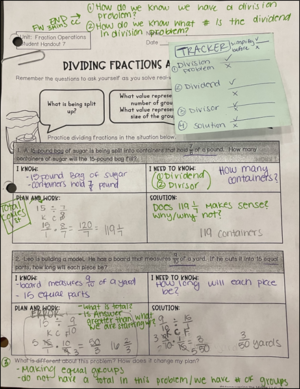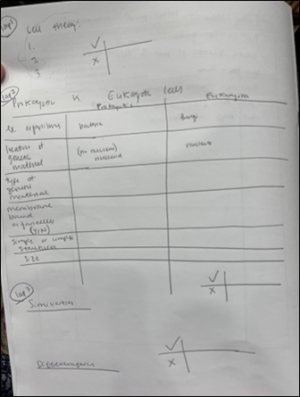09.24.23We Loved These Examples of Lesson Preparation from Our Recent Workshop
TLAC team members Teneicesia White and Sadie McCleary recently returned from leading a workshop in Raleigh, NC, where the focus was on Checking for Understanding. While there they gathered some fantastic examples of Lesson Preparation from teachers who joined them! Sadie was so inspired she shared this analysis:
This example of Lesson Preparation from Paige, a 6th/7th grade math teacher is a great example of the kind of Lesson Preparation work teachers were sharing.

The lesson plan is reflected on the printed page. It involves a sequence of problems and questions. But the lesson preparation consists of the things Paige has hand-written on her plan. It shows what she’s thinking about as she gets ready to teach. Fortunately, she’s used two colors so we can see some of the steps she takes more clearly.
She’s written out her Exemplar in blue pen and pencil. She has Planned for Error with her back pocket questions in green. When Paige implements this lesson, she’ll be able to circulate thoughtfully, checking student responses against her exemplars and quickly recognize where to give them feedback. But she’s likely to do a very good job of this because she’s thought through the mistakes she’s likely to see and the questions she might ask in response: “Does 119 1/7 make sense? Why or why not?” and “What is total? Is [the] answer [going to be] greater than what we are starting with?”
In the upper left-hand corner she’s written: “EW 3 mins → CC”. It means she’ll use “Everybody Writes for 3 minutes and then Cold Call… she’s thought through not only what questions to ask but how students will answer—her Means of Participation.
And then there’s Post-It. She said she was planning to create a different Post-It for each class period, which would allow her to track data efficiently but without cluttering up her Lesson Prep document.
With thoughtful and practical preparation like that, Paige is likely to crush it.
Here’s another example! This teacher, MJ, a 9th grade Biology teacher, decided to create a data tracker that will allow her to quickly and efficiently use tallies as she circulates to identify ideas she needs to review with students.

Note her ‘laps’ – these indicate when she will ‘lap’ around the room and what she will be looking for. In lap 1, she’s going to remain laser-focused on looking for the 3 components of cell theory, even if a student has moved onto the next part of the task. We think this is supportive in a few ways:
- It will free her working memory to look just at one piece of every student’s work so she’s not having to think through multiple exemplar responses at once.
- She will quickly know if she needs to review cell theory with the entire class or if they have a solid grasp and can move onto the similarities and differences in prokaryotes and eukaryotes.
- MJ won’t get ‘stuck’ at a student’s desk giving feedback. She might say, ‘The second component of the cell theory you wrote is incorrect; check your notes,” and then move onto the next student.
We think laps are helpful because you can also use them to announce to students what you’ll be looking for as you circulate. “In my first lap around the room, I’m looking that you have the 3 components of cell theory. If I put a check, you’re correct, and if I circle one of them, I want you to check it against your notes.”
Importantly, both Paige’s and MJ’s Lesson Preparation documents were created over the course of a combined 25 minutes of practice time during our workshop.
More on the Distinction between Lesson Planning and Lesson Preparation.
- Lesson Plans, what teachers are often most familiar with, detail what content will be taught within a carefully constructed sequence of activities. The sequence is usually aligned to an instructional framework and designed to occur within a defined block of time. Here’s an snapshot of a lesson plan from a unit on Number the Stars in our Reading Reconsidered curriculum:
- Lesson Preparation, the focus of this post, consists of answering a series of questions about how you will teach the content outlined within a lesson plan to ensure all students experience mastery. We think this is where the magic happens. We think there are 3 foundational steps to Lesson Prep:
- Plan the Exemplar: Draft the ideal response, including vocab and key ideas, you’d expect your students to produce for core tasks and questions.
- Plan for Error (& Challenge): Anticipate and plan responses to gaps or errors that may appear in student responses. Plan questioning for Right is Right and Stretch It.
- Plan Means of Participation: Script how you want students to engage with tasks or questions within a lesson. Be sure to plan the entire sequence.
Want to learn more?
Blog Post: Examples of Lesson Preparation and Adaptation from Teachers at Believe Memphis Academy
Blog Post: Lesson Preparation: How Christine Torres Prepares to Teach
